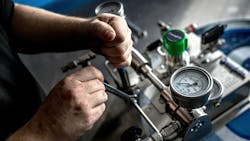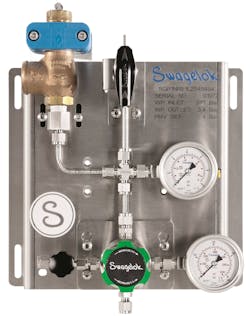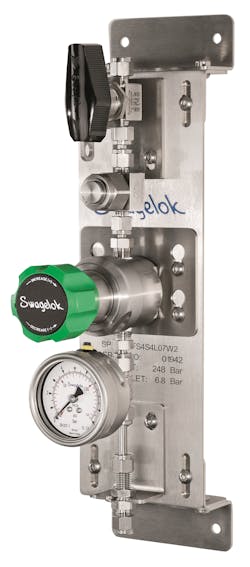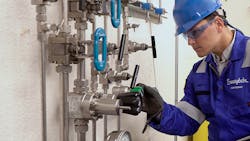How to control costs and improve safety in gas distribution systems
The primary reason gas distribution systems are often overlooked and underappreciated is that they are frequently treated as utilities, meaning they are simply expected to work in the background without attention. In addition, they often span an entire operation, so no one specific department is responsible for the whole system, and other operational matters can take plant managers’ attention away from the necessary oversight and maintenance of this vital system.
To keep all departments that rely on a steady gas supply up and running, proper ongoing gas distribution system maintenance is critical. Here are some ideas about how to improve the functioning of this essential plant system to help maintain your plant’s profitability and safety.
What is a gas distribution system?
At its core, a gas distribution system consists of pipes, tubes and other components that move pressurized gas from an origin point to where it will be used in an application (Figure 1). Usually, such systems offer access points to a supply system, reduce source pressure to the lowest acceptable level, provide an uninterrupted supply of critical gases and may be required to handle reactive, toxic, corrosive or high-purity gases.
The stakes are high if a gas distribution system is not performing optimally. If process gases manage to escape the system under high pressures or at high temperatures, any employees in the area are at risk of injury, even if the gas is not toxic. When these systems do carry hazardous, toxic or flammable gases, employees and equipment are at significant risk if unnoticed leaks go unaddressed. In addition, the damage overpressurization can cause downstream can mean expensive repairs or replacement if the excess pressure is severe enough.
Even in situations in which the gas itself is harmless, leaks can lead to unintended financial losses. A nitrogen leak, for example, could result in tens of thousands of dollars in losses annually if it goes unaddressed for long, even though nitrogen itself is an inexpensive gas. If the gas is more expensive, like helium, the costs can compound even more quickly.
Gas distribution subsystems explained
As with most industrial systems, safe, efficient gas distribution systems begin with choosing the right components. Doing so will help operators ensure the gas from a supply source arrives at its point of use at a stable pressure — one of the main functions of a gas distribution system. To achieve this goal, four key gas subsystems are usually involved: a source inlet connection, primary gas pressure control, an automatic changeover and a point of use assembly.
Here’s a rundown of what each subsystem does:
- The source inlet (Figure 2) is the point at which high-pressure gas connects with the distribution system. It is built with several different components, including cylinder connections, hoses, tubing, filters and vent, purge and relief capacity. Choosing the proper components is essential, particularly if the gas panel does not have a standard source inlet. Technicians should always check componentry carefully and evaluate whether the gas panels have the right cylinder connector. In some cases, with high-pressure and/or hazardous gases, the source inlet may also need specific hoses designed for those applications.
- The primary gas pressure control panel (Figure 3) performs the initial pressure reduction as the gas moves to the next stage of the system. Typically, the primary gas pressure control panel achieves pressure reduction either with a single pressure regulator or a dual pressure regulator arrangement, depending on the application. Precisely understanding the proper inlet and delivery pressures is not always easy, but it is essential. Technicians should consider differences in media and other factors that will affect the proper pressurization of the gases in question. In addition, many gas bottles that have two-stage pressure regulators may not need them. If this setup is unnecessary, system owners have a chance to lower their overall costs.
- The automatic changeover panel (Figure 4) is the component that allows one gas source to shift to another while keeping the supply uninterrupted to crucial points of use. In most instances, this is accomplished using staggered set points of two pressure regulators, which allows the system to continue operation even as primary gas sources are changed. Using an automatic changeover panel minimizes waste by maximizing how much gas you get out of each bottle. It also removes the potential for human error during changeover events, saving labor costs and lowering employee risk.
- The point of use (Figure 5) is the last line of defense against overpressurization. It consists of a pressure regulator, gauge and isolation valve to provide operators convenient and accurate opportunities to adjust pressures as necessary. Though varying line pressure between the primary gas pressure control and point of use may occur, single-stage pressure regulators may lower costs and reduce the system complexity.
How to select components
Choosing the wrong components for your application is the most common reason gas distribution systems are unsafe or costly. Since there are so many general industrial fittings, valves, regulators and other components on the market, it may be confusing and difficult to specify the right ones.
For example, deciding which pressure regulator to use is determined by several key considerations, including whether the regulator will be able to handle your system’s pressures, provide the correct flow capacity and be made of compatible materials that will not degrade over time. Once you’ve chosen the right components, the next step is properly designing your system.
How to design your system
It is important to think through a system’s design from beginning to end to make sure the components will operate correctly to maximize the system’s safety and efficiency (Figure 6). For example, to reduce potential leaks the subsystems should have limited threaded connections.
Additionally, maintenance and operation of the system should be taken into consideration and made as intuitive as possible. Each component should be clearly labeled so technicians do not have to struggle to understand what those components do while reducing the potential for user errors during maintenance.
While attention to specific subsystems is critical, the overall design of the system cannot be overlooked. It should be designed to streamline operations for their intended function and purpose. It does not matter whether you are designing a system from scratch or modifying an existing one. Consistent, thoughtful choices about tube routing, component selection, and more will ensure the system is safe and efficient.
Proper installation and assembly are key
Poorly assembled systems, combined with inadequate testing prior to pressurization, can have a significant impact on not only the system’s long-term performance but the safety of employees and others. Training on fluid system installation and assembly is critical to ensure systems are installed and assembled correctly from the beginning (Figure 7). Additionally, operators must be trained on how to use and maintain the systems once they are installed.
How to maintain your gas distribution system
If gas panels are thoughtfully installed and assembled, maintenance costs can be significantly lowered. Gas panels should have primary components like regulators on the front so they are easier to access when maintenance becomes necessary.
Simplified access to regulators can result in:
- 30 minutes to two hours of time savings, depending on conditions.
- Thousands of dollars in savings at each maintenance interval.
Fortunately, you are not alone when it comes to deciding how to design, build and assemble new systems or evaluate older systems. Reputable suppliers should be able to offer advice on which pressure control devices will be appropriate for your specific application. It may also be helpful to use preengineered, fully tested, standardized subsystems if your supplier provides them. Doing so will eliminate the need for your engineers to learn about each individual component and make it much easier to procure systems. In addition, suppliers may be able to modify such systems to address issues that may exist in your system.
Have a second pair of eyes on the system
It may make sense to bring in third-party evaluators to get their input and advice on larger system upgrades, proper regulator sizing and selection, and even the design and assembly of engineered solutions. Suppliers should act as consultants and be familiar with the gas delivery challenges you face. They should be able to suggest modifications to meet whatever specific requirements you have (Figure 8).
Gas distribution systems are vital components for the safe and efficient operation of your facility. Give them the attention they deserve, and they will function properly for their lifetime, saving you money and improving safety in the process.
Jeff DeWitt is an Applications Engineer for Swagelok Company.
An original version of this article appeared on the Swagelok Reference Point blog here: www.swagelok.com/en/blog/improve-gas-delivery-safety-efficiency.
About the Author
Jeff DeWitt
Applications Engineer, Swagelok Company
Jeff DeWitt is an applications engineer for Swagelok Company.







